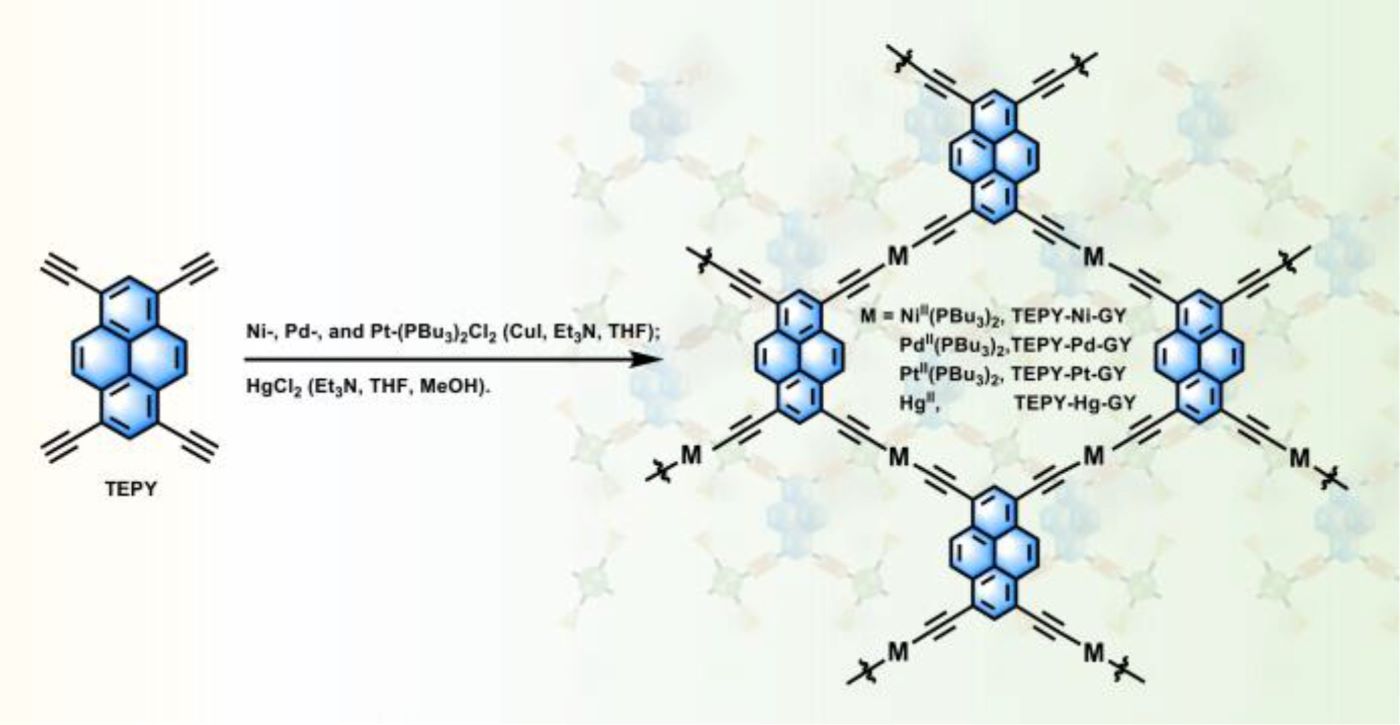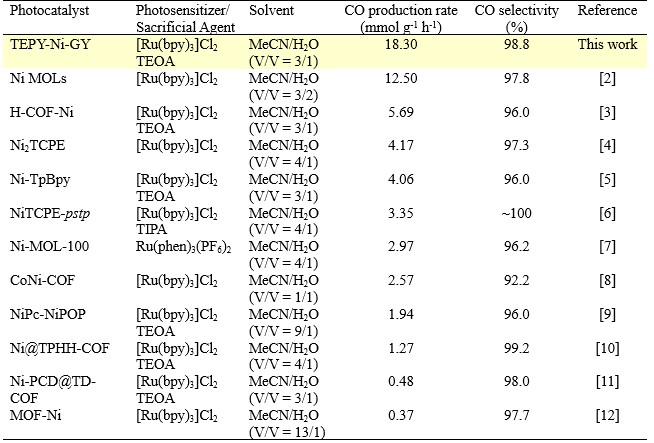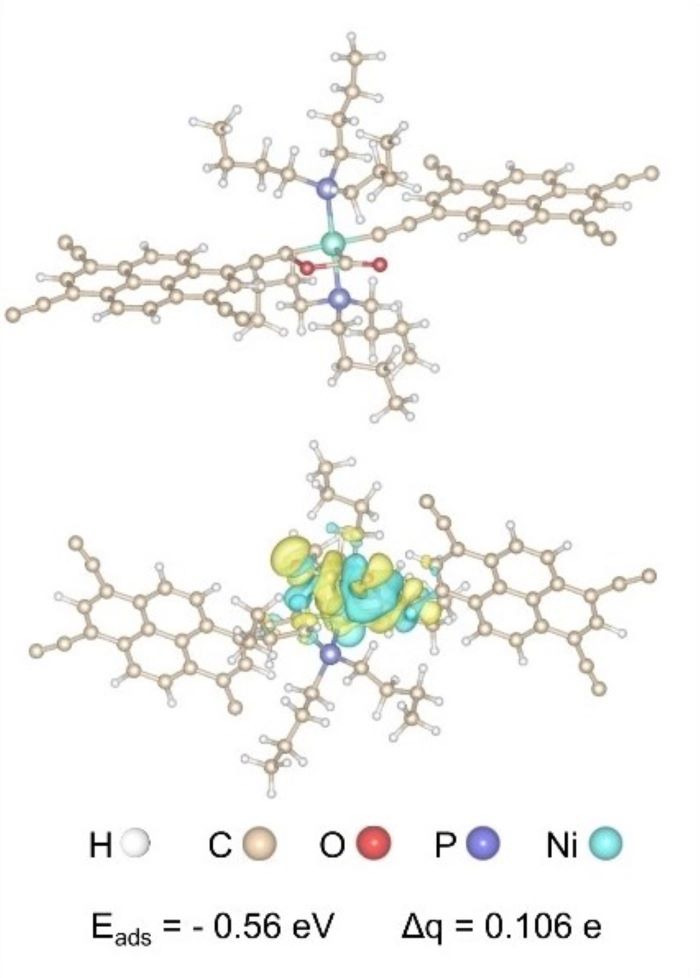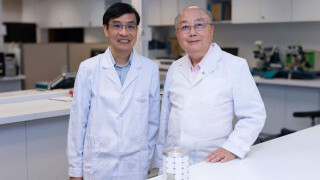Synthesis of Low-Cost Metalated Graphyne for Efficient Photocatalytic Carbon Dioxide Reduction
Other Articles

A "bottom-up" strategy for constructing metal-acetylide framework materials.
Study conducted by Prof. Raymond Wai-Yeung WONGand his research team
Efficient CO2 reduction is crucial in combating climate change. Carbon dioxide reduction reactions (CO2RR) are promising not only for reducing CO2 emissions but also for converting CO2 into valuable chemicals and fuels, thereby achieving resource recycling with significant economic and environmental implications. Various catalysts have been explored to promote CO2RR, with recent research on molecular catalysts focusing on the design of efficient electron transport channels from ligands to the metal active centre Note1, ensuring greater electron participation in the CO2RR process.
In this context, metalated graphyne (MGY), which incorporates metal atoms into the graphdiyne (GDY) framework Note2, facilitates efficient electron transfer and provides active sites that lower the energy barrier for CO2 conversion, resulting in improved reaction efficiency. Several types of MGY-based molecular catalysts, featuring GDY structures with metal ions such as silver (Ag), gold (Au), and mercury (Hg), have been studied. However, there is a need to explore and synthesise further MGYs that are cost-effective and exhibit high catalytic activity.
Writing in Angewandte Chemie International Edition, a research team led by Prof. Raymond Wai-Yeung WONG, Dean of the Faculty of Science, Chair Professor of Chemical Technology of the Department of Applied Biology and Chemical Technology, and Clarea Au Professor in Energy at The Hong Kong Polytechnic University, reported successfully the synthesis of highly conjugated MGY photocatalysts based on four different transition metal ions for the first time [1].
By applying a base-catalysed dehydrohalogenation reaction Note3, the research team successfully constructed larger and more complex metal-acetylide framework materials from small molecular units. Specifically, the researchers used 1,3,6,8-tetraethynylpyrene (TEPY) as a highly conjugated organic ligand, which reacts with transition metal complexes for the formation of (-C≡C-M-C≡C-) units, to precisely embed the metal centres within the GDY framework (Figure 1). This approach not only ensures a uniform distribution of metal atoms but also enhances the structural stability and catalytic activity of the resulting catalyst. Subsequently, a series of characterisation techniques were employed to confirm the structure and morphology of the synthesised TEPY-M-GYs, laying a foundation for the subsequent evaluation of photocatalytic performance.

Figure 1. Illustration of the synthesis of TEPY-M-GYs.
Through experiments, the research team successfully introduced four transition metal ions using nickel, palladium, platinum and mercury (M = NiII(PBu3)2, PdII(PBu3)2, PtII(PBu3)2 and HgII respectively) into the GDY framework. The four synthesised MGY photocatalysts (TEPY-Ni-GY, TEPY-Pd-GY, TEPY-Pt-GY and TEPY-Hg-GY) exhibit a well-defined 2D layered structure and distinct properties that enhance their catalytic performance. The incorporation of transition metals into the GDY framework facilitates efficient charge transfer and enhances the stability of active sites. Furthermore, the high conjugation of the organic ligand contributes to improved electron delocalisation, further promoting the photocatalytic reduction of CO2. Among the four synthesised photocatalysts, TEPY-Ni-GY demonstrates the highest photocatalytic activity, achieving a CO production rate of 18.3 mmol g-1h-1 with a selectivity of 98.8% and activity for CO2-to-CO conversion, outperforming other benchmark Ni-based organic catalysts under visible light irradiation (Table 1). Additionally, TEPY-Ni-GY exhibited excellent stability and reusability during continuous photocatalytic cycles over 20 hours, highlighting its potential for practical applications.
Table 1. Photocatalytic performance of reported Ni-based organic catalysts for converting CO2 to CO under visible light irradiation.
(in descending order of the CO production rate)

In situ diffuse reflectance infrared Fourier transform spectroscopy (DRIFTS, a technique for analysing a material's composition by measuring infrared light reflected from its surface) and density functional theory (DFT) calculations revealed that the pyrene ring functions as an electron transport channel, facilitating the separation and transfer of charge carriers. Meanwhile, the -C≡C-Ni(PBu3)2-C≡C- site serves as a functional catalytic active centre for the adsorption and activation of CO2 (Figure 2). This in-depth understanding of the mechanism provides a theoretical basis for the future design of catalysts.

Figure 2. Schematic illustration of *CO2 adsorbed onto TEPY-Ni-GY.
Eads: adsorption energy – a negative value suggests the presence of interaction between CO2 and TEPY-Ni-GY.
Δq: difference of Bader charge – a positive value suggests the presence of electrostatic interaction between CO2 and TEPY-Ni-GY.
Yellow and cyan iso-surfaces represent electron accumulation and electron depletion, respectively.
In summary, this research offers valuable insights into the design and development of efficient, low-cost photocatalysts for CO2 reduction, establishing a solid foundation for the advancement and application of MGY materials. It not only broadens our understanding of the diversity of GDY structures but also showcases the potential of low-cost nickel-based graphyne functional materials in catalytic applications. Building on these ground-breaking findings, the research team is conducting extended research to optimise the catalytic performance of MGYs and expand their applications in other catalytic reactions.
The research is supported by the Research Grants Council of Hong Kong (Grants PolyU 15307321 and PolyU 25301524) and the RGC Senior Research Fellowship Scheme (Grant SRFS2021-5S01). Additional support comes from the Research Institute for Smart Energy, the Research Centre for Nanoscience and Nanotechnology, the Research Centre for Carbon-Strategic Catalysis, the Guangdong Provincial Natural Science Foundation-General Project (Grant 2024 A1515010422), The Hong Kong Polytechnic University (Grants WZ0Z, BEBA, CDB5, CE2N), the PolyU Shenzhen Research Institute (Bai Cheng Bai Yuan Special Launch Fund), and the National Natural Science Foundation of China (Grant 22309156).
Supporting information for this study is available at:
https://onlinelibrary.wiley.com/action/downloadSupplement?doi=10.1002%2Fanie.202418269&file=anie202418269-sup-0001-misc_information.pdf
Data sources can be obtained from the corresponding authors upon request.
Prof. Wong was named as a "Highly Cited Researcher" by Clarivate Analytics for seven consecutive years from 2014 to 2020. He was ranked among the top 2% most-cited scientists worldwide (for career-long) by Stanford University for six consecutive years from 2019 to 2024. Prof. Wong has gained international recognition for his significant contributions to the field of chemistry, and he was awarded the inaugural RGC Senior Research Fellowship in 2020 and elected as a Foreign Member of the European Academy of Sciences in 2023. Prof. Wong is currently the Associate Director of the Otto Poon Charitable Foundation Research Institute for Smart Energy of The Hong Kong Polytechnic University.
Notes |
|---|
Ligands are molecules or ions that bind to a central metal atom or ion, known as the metal active centre. This interaction forms a coordination complex that can influence the metal's reactivity and properties.
Graphyne (GDY) is an emerging 2D carbon allotrope with a distinct structure of acetylenic linkages (carbon-carbon triple bonds) alongside a hexagonal arrangement of carbon atoms. This structure imparts controllable electronic properties and superior electron transfer capabilities.
A chemical process that is commonly used for the synthesis of doubly bonded compounds.
| References |
|---|
[1] Qin, Y., Wang, Y., Lu, J., Xu, L., & Wong, W.-Y. (2024). A Highly Conjugated Nickel(II)-Acetylide Framework for Efficient Photocatalytic Carbon Dioxide Reduction. Angewandte Chemie International Edition, e202418269. https://doi.org/10.1002/anie.202418269
[2] B. Han, X. Ou, Z. Deng, Y. Song, C. Tian, H. Deng, Y. Xu, Z. Lin, Angew. Chem. Int. Ed. 2018, 57, 16811-16815.
[3] S. Yang, R. Sa, H. Zhong, H. Lv, D. Yuan, R. Wang, Adv. Funct. Mater. 2022, 32, 2110694.
[4] H. Zheng, S. Huang, M. Luo, Q. Wei, E. Chen, L. He, Q. Liu, Angew. Chem. Int. Ed. 2020, 132, 23794-23798.
[5] W. Zhong, R. Sa, L. Li, Y. He, L. Li, J. Bi, Z. Zhuang, Y. Yu, Z. Zou, J. Am. Chem. Soc. 2019, 141, 7615-7621.
[6] H. Zheng, J. Zhao, Y. Sun, A. Zhang, Y. Cheng, L. He, X. Bu, J. Zhang, Q. Lin, J. Am. Chem. Soc. 2023, 145, 27728-27739.
[7] W. Yang, H. Wang, R. Liu, J. Wang, C. Zhang, C. Li, D. Zhong, T. Lu, Angew. Chem. Int. Ed. 2021, 60, 409-414.
[8] J. Wang, W. Zhu, F. Meng, G. Bai, Q. Zhang, X. Lan, ACS Catal. 2023, 13, 4316-4329.
[9] X. Dong, Y. Si, Q. Wang, S. Wang, S. Zang, Adv. Mater. 2021, 33, 2101568.
[10] M. Dong, J. Zhou, J. Zhong, H. Li, C. Sun, Y. Han, J. Kou, Z. Kang, X. Wang, Z. Su, Adv. Funct. Mater. 2022, 32, 2110136.
[11] H. Zhong, R. Sa, H. Lv, S. Yang, D. Yuan, X. Wang, R. Wang, Adv. Funct. Mater. 2020, 30, 2002654.
[12] X. Wang, J. Liu, L. Zhang, L. Dong, S. Li, Y. Kan, D. Li, Y. Lan, ACS Catal. 2019, 9, 1726-1732.
 | Prof. Raymond Wai-Yeung WONG Clarea Au Professor in Energy |




